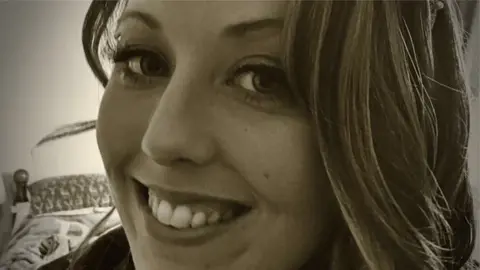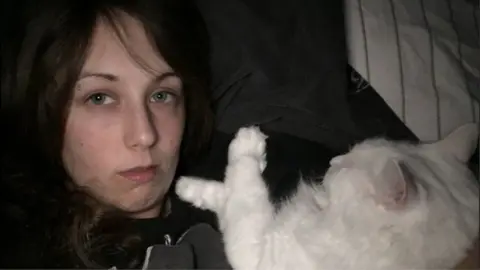Endometriosis: 'Don't give up on getting help'
 Megan
Megan"It's taken three different hospitals and countless GPs and gynaecology specialists to get to this point. I'd like women to see that it is worth pushing and fighting, no matter what, and not to give up."
Megan is one of the estimated one-and-a-half million women in the UK living with endometriosis - where cells like those that line the womb develop in other parts of the body. It can cause painful and heavy periods, as well as infertility, fatigue and bowel and bladder problems.
The condition made headlines recently when Girls TV series writer and actress Lena Dunham announced her decision to undergo a hysterectomy at the age of 31.
Megan, now 28, wanted to tell her story during Endometriosis Awareness Week about the bad - and now the good - treatment she has had.
'It's normal'
"As soon as my periods started, when I was 12, the problems began. I had extreme pain and heavy bleeding, and I passed out several times," Megan says.
Her GP told her "every girl has this, it's normal", but put her on the pill to help with the heavy bleeding.
It was when Megan was in her early 20s that the problems really started. She had switched GPs and couldn't get the same pill any more. The replacement caused migraines - so she came off it and found that her hormonal symptoms became worse and worse.
One day, she went online.
"I Googled my symptoms, desperate to try and find an answer. The very first link threw up a word I had never even heard before but would literally take over and consume my life the very moment I read it - endometriosis. Every symptom fitted."
Her GP referred her to the gynaecology department at her local hospital - but she had to wait six months.
"I was suffering during that whole time. It was at a moderate level every day, and it peaked around my period and when I ovulated.
 Megan
Megan"The doctor gave me Oramorph [oral morphine] for if the pain was really bad - it was a last resort after other painkillers, nerve blockers and hormone control - but most of the time it barely touched it."
When she finally had her gynaecology appointment, doctors offered Megan an exploratory procedure to check for endometriosis - though they told her it was "very unlikely".
She had a laparoscopy in February 2016.
"Literally all the surgeon said to me was 'we found endometriosis, we treated it, you will have no more problems'.
"I was happy and relieved. I was very naive to the fact that this fight was far from over."
She did initially feel better, and started a new job. But by October that year, her symptoms were returning.
"I was told it couldn't have come back after the surgery. It was part of being a woman.... and that I 'needed to be more positive'... They told me to go for a run - but how could I do that if I couldn't even get to the bathroom?"
Eventually, Megan heard about the Norfolk and Norwich hospital, which had been accredited as a specialist endometriosis hospital - so she asked to be referred there.
"The difference in the level of care was indescribable.
"It was such a relief to have someone that actually believed me, that it wasn't all in my head - it wasn't normal."
 Megan
MeganAn MRI scan showed her left ovary and her bowel are stuck to her cervix and doctors have told Megan her pain and symptoms made them "almost 100% certain" her endometriosis is back.
Despite the diagnosis, she feels more positive.
"Once again I cried when I was leaving hospital - but this time it was tears of relief."
Megan, who works as a postwoman, has been told she needs another laparoscopy. She doesn't really want to have more surgery, but says it's good to have "an action plan".
"Endometriosis is really exhausting to live with, and people can't see it. It's been quite difficult, Luckily I have good support at home and at work.
"It takes over your whole life. I've given up playing rugby and horse riding. I barely go out because I always have to cancel and I don't want to risk having a few drinks in case it means I can't take my pain medicine.
"I wasn't living any more, merely existing."

Diagnosis
- Can take time - symptoms are very similar to other conditions
- Laparoscopy - a procedure where a camera is used to look at the pelvic organs and check for signs - the only way to definitively diagnose the condition
- Endometriosis can be treated and removed during the same procedure
- It takes an average of seven-and-a-half years from first seeing a doctor to a diagnosis
Treatment
There is no cure - but there are three main forms of treatment:
- Pain relief - painkillers, heat, physiotherapy or Tens machines
- Hormone treatments - which will mimic pregnancy or menopause
- Surgery - this can be conservative (removing the endometriosis tissue deposits), complex (if organs such as the bladder or bowel are affected) or radical (where the womb or ovaries are removed)
Source: Endometriosis UK

Megan says she can't believe it's taken her so long to find sensitive specialists.
"It's such a relief to have someone say 'yes, that sounds right' and not doubt you. But everyone should have that level of support. It's the NHS - it's not like I went private.
"I'm in a couple of groups on Facebook and everyone's saying the same thing - 'in this day and age, how come it's so bad?'."
You may also be interested in:
Edward Morris is the consultant leading the service at the Norwich and Norfolk - one of a number of centres around the country.
He said women should be reassured there is help available.
"If you're being managed by a GP and you're unhappy, you can ask to be referred to the nearest gynaecology unit. If you're at a gynaecological unit, and have a diagnosis of endometriosis and it's not helping, you are entitled to ask to be referred to an endometriosis centre.
"It's very rare that an endometriosis centre cannot help a woman".